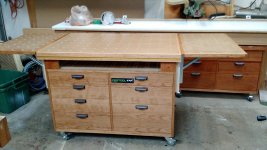Hello, I got the Parf Guide and started making few holes to tray some materials and the performance of my cordless drill I have. My material of choice is Baltic Birch Ply however I am not sure it is the right choice. The table top will measure 60"x24". Here the issue:
1) I drilled a couple of 3mm holes in 3/4 BB ply and the 3mm pins do not get in easily. Actually, it is a struggle. They are very hard to go in and they have a lot to resistance to be taken off the holes. Am I doing the right thing? Did you have the same problem? Do I have to use 3-in-1 oil for the 3mm bit too? Is the Baltic Birch the problem? Is it the drill?
2) Is Baltic Birch an over kill for a MFT kind of top? Should I use MDO instead?
3) I do not have the option of getting a good MDF sheet (like Ultralite), what is the second best after MDF?
Thanks in advance for your help. K
1) I drilled a couple of 3mm holes in 3/4 BB ply and the 3mm pins do not get in easily. Actually, it is a struggle. They are very hard to go in and they have a lot to resistance to be taken off the holes. Am I doing the right thing? Did you have the same problem? Do I have to use 3-in-1 oil for the 3mm bit too? Is the Baltic Birch the problem? Is it the drill?
2) Is Baltic Birch an over kill for a MFT kind of top? Should I use MDO instead?
3) I do not have the option of getting a good MDF sheet (like Ultralite), what is the second best after MDF?
Thanks in advance for your help. K



